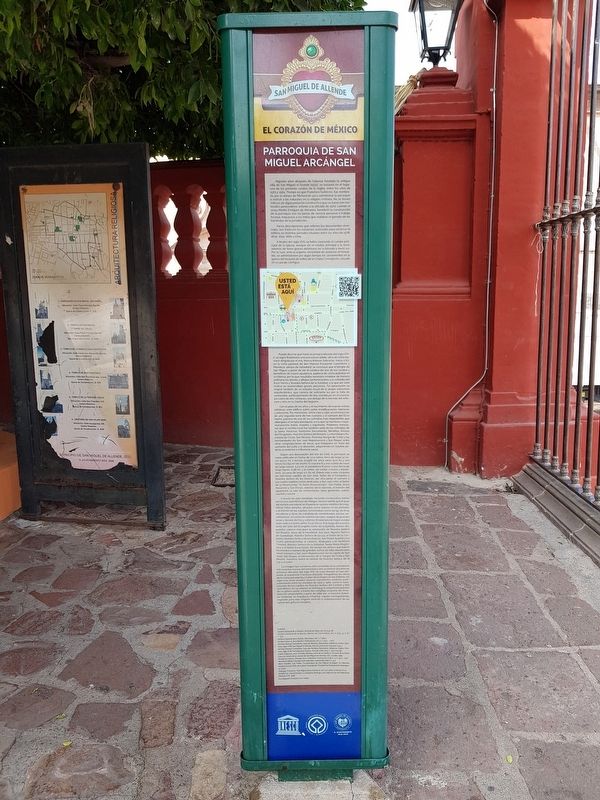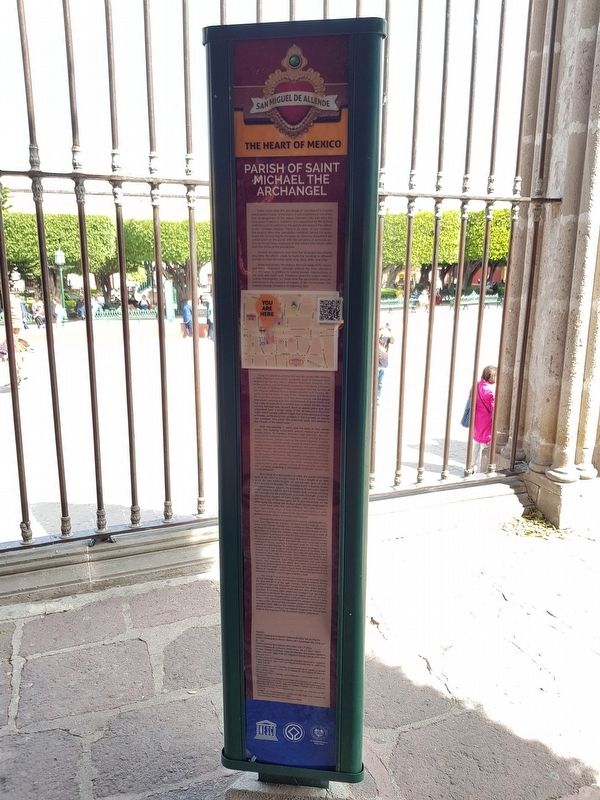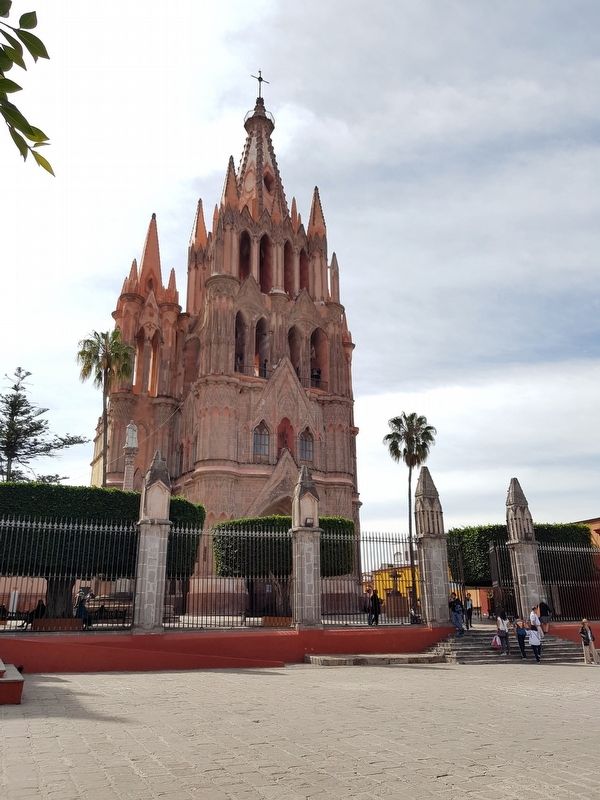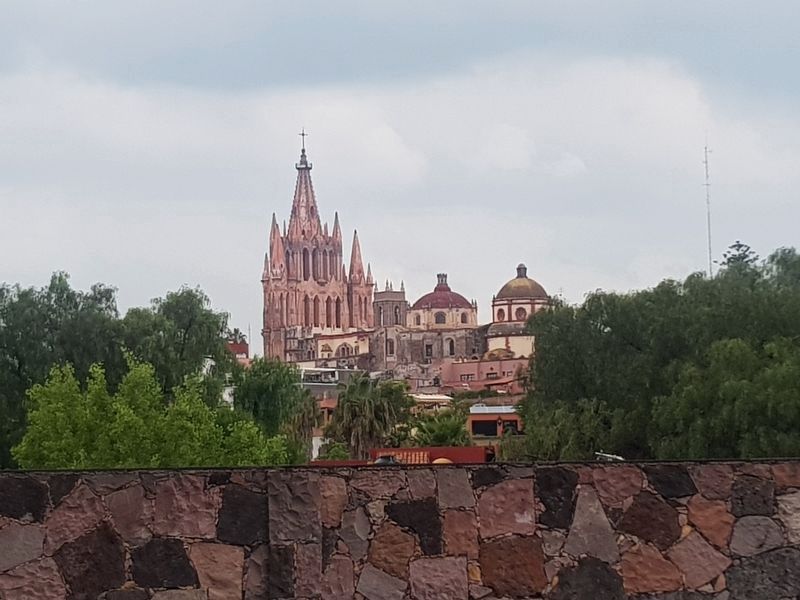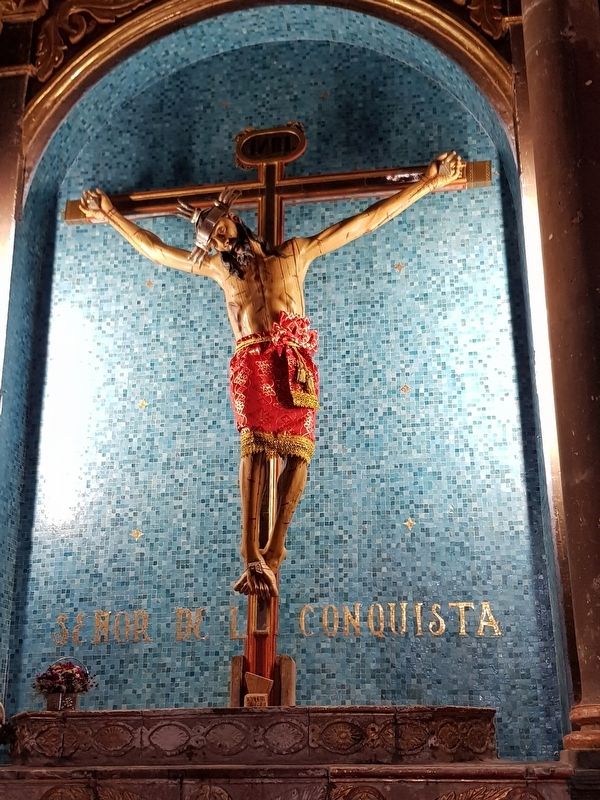San Miguel de Allende, Guanajuato, Mexico — The Central Highlands (North America)
Parish of Saint Michael the Archangel
San Miguel de Allende - El Corazón de México
Algunos años después de haberse fundado la antigua San Miguel el Grande (1555), se instauró en el lugar, uno de los primeros curatos de la región, entre los años dde 1563 y 1564. Tiempo en que Francisco Gutiérrez, fue nombrado por el obispo de Michoacán para administrar la parroquia e instruir a los naturales en la religión cristiana. No se tienen noticias de algún proyecto constructivo que no fuese con materiales perecederos anterior a la década de 1570, cuando el virrey Martín Enríquez de Almanza, benefició la construcción de la parroquia con las penas de servicio personal o trabajo forzoso, impuestas a los indios que mataban el ganado de las haciendas de la jurisdicción.
Varias descipciones que refieren los documentos virreinales, nos traducen los esfuerzos realizados para construir el edificio en distintos períodos situados entre los años de 1578, 1639, 1649, 1680 y 1709.
A finales del siglo XVII, se había concluido el cuerpo principal de la iglesia, aunque sin el retablo principal y la torre, además de tener graves deterioros en la bóveda y muro sur. Por cual, ante la urgente necesidad de restaurar el inmueble, se administraron por algún tiempo los sacramentos en la iglesia del hospital de indios de la Limpia Concepción, situado en un paraje contiguo.
Puede decirse que hasta la primera década del siglo XVI-II, se logró finalmente una estructura sólida, obra de estilo barroco dirigida por el Arq. Marco Anionio Sobrarías. Hacía 1707, en la visita pastoral de don Manuel Escalante Colombres y Mendoza, obispo de Valladolid, se concluyó que el templo de San Miguel a pesar de ser el cerebro de uno de los curatos y beneficios de mayor opulencia, padecía de cierta pobreza en su fábrica, por lo que resultaba necesario emplear de manera ordinaria los bienes y alhajas pertencecientes a la cofradía del Ecce Homo y Nuestra Señora de la Soledad, a la que por este motivo se ocasionaban graves perjuicios. Tal apreciación se originó también de un estudio visual de la propia estructura aquitectónica, que carecía de suficiente luz por la falta de ventanales, particularmente de los claraboyas en el crucero, así como de dos ventanas, una debajo de la bóveda del antecoro y otra en la Capilla del Sagrario.
Con el paso de los años y el nacimiento de nuevos estilos artísticos, este edificio sufrió varias modificaciones interiores y exteriores. Por mencionar, entre 1740 y 1750, la construcción de una sagrada torres de dos cuerpos y el camarín de Ecce
Homo, patrono de una de las cofradías mas importantes que albergaba el templo parroquial, en la que se reunieron mayoritariamente indios, mulatos y españoles. Podemos mencionar que el recinto cural fue también sede de las cofradías de la Santa Veracruz, Santísimo Sacramento, Benditas Ánimas
del Purgatorio, Nuestra Señora del Rosario, La Humildad y Paciencia de Cristo, San Nicolás, Preciosa Sangre de Cristo y hermandades de San Juan Nepomuceno y San Roque, entre otras congregaciones de laicos, que trabajaron en favor del aumento del culto y la devoción, adquieriendo un notable poderlo económico e influencia social.
Según una descripción del año 1766, la parroquia se había edificado en forma de cruz latina; tenía de largo 52 varas (43.57 m); 2 tercios (0.5586 m), once varas (9.21 m) y una tercia (0.2793 m) de ancho. El crucero 6 y una cuarta de varas de largo (aprox. 5.23 m); el presbiterio 8 varas y una tercia de largo (aprox. 6.98 m); y el cañón, sin contar crucero y presbiterio, 33 varas de largo (27.65 m). Daban vida a este conjunto las hermosas capillas de San José, Señor de la Conquista y Nuestra Señora de los Dolores; por otra parte, el camarín y sus cuatro capillas cortas dedicadas a San Juan niño, el Señor de la Misericordia, “la Santa Resurección”, San Pedro, Jesús Nazareno y San Dimas; además de la sacristía, el tránsito del aguamanil, la sala de
conferencias, salas generales, patios, cuartos y cocina.
A través de este detallado recuento constructivo, hecho por el cura Juan Manuel de Villegas, hemos sabido que el ajuar del templo parroquial se disponía en quince retablos de magníficas tallas doradas, situados como adorno on las portadas o al interior de las capillas; funcionaban como abrigo de finas esculturas y obras de caballete do renombrados artistas novohispanos, así como de vistosos herrajes, espejos de grandes lunas y lienzos de tisú y contense; El coro lateral mayor estaba reservado a nuestro señor Ecce Homo. A lo largo del crucero, tanto del lado del Evangelio como de la Epistola, fueron dispuestos catorce más para la veneración de Nuestra Señora de la Luz y el coro).
La imagen que conserva este inmueble en la actividad, nos muestra el paso del neoclásico por su interior durante las primeras décadas del siglo XIX; de cuyo tiempo se han atribuido al arquitecto Francisco Eduardo Tresguerras las obras de la cripta parroquial y el altar de la Virgen de los Dolores. Un siglo más tarde pueden situarse importantes cambios, particularmente entre las décadas de 1930 y 1960, como la construcción de las capillas de Nuestra Señora del Carmen y San Juan Bosco. En su exterior se distingue la adaptación popular de un gótico tardío, a través del complejo proyecto de remodelación emprendido a partir de 1880 por
el maestro Zeferino Gutiérrez, un arquitecto empírico, orgullo sanmiguelense, inspirado para esta singular obra en la majestuosidad de las catedrales góticas europeas.
Fuentes:
Archivo General de la Nación, General de Parte, Vol. 20, Exp. 80.
Archivo General de la Nación, Bienes de Comunidad, Vol. 7, Exp. 13, F.67-77v.
Archivo General de la Nación, Mercedes, Vol. 7, F. 269 v.
Archivo General de la Nación, Ordenanzas, Vol. 2, F. 219 v-220 f.
Archivo Manuel Castañeda, Casa de Morelos, Diocesano, Gobierno, Visitas, Informes, Siglo XVIII, San Miguel el Grande, Año de 1707, 0215, Caja 490, Exp. 1.
Archivo Manuel Castañeda, Casa de Morelos, Diocesano, Gobierno, Visitas, Informes, Siglo XVIII, San Miguel el Grande, Año de 1766, 0215, C. 503, Exp. 65.
López Espinosa, José Cornelio Historia y Arte de la Capilla y Camarín de la Santa Casa de Loreto de la ciudad de San Miguel de Allende, Gto, Inédito, 1999.
Newberry Library, Chicago Ayer Collection, manuscrito 1106 C.3 F. 131 v-132f.
Newberry Library, Chicago, Ayer Collection, manuscrito 1106 A.F. 44v.
Nieto Garniño, Luis Felipe, “La parroquia de San Miguel Árcangel” en Miranda Montero Arturo, Ruta de la plata, Guanajuato, Presidencia Municipal de Guanajuato, 2000.
Vidargas, Francisco “San Miguel en la memoria”, en Con sabor a México, P.14
Wright Carr, David
Charles La conquista del Bajío y los orígenes de San Miguel de Allende, FCE, 1998.
Investigación: Graciela Cruz López.
Parish of Saint Michael the Archangel
Some years after the old village of San Miguel el Grande was founded (1555), in the place, it was established one of the first congregations of the region, between 1563 and 1564, the time when Francisco Gutiérrez was appointed by the Bishop of Michoacán to administer the parish and instruct the natives in the Christian religion. There is no news of any constructive project other than perishable materials when the Viceroy Martín Enríquez de Almanza benefitted the construction of the parish with the penalties of personal service or forced labor, imposed on the Indians who killed cattle from the farms of the jurisdiction.
Several descriptions that refer the viceregal documents elucidate the efforts made to build the building in different periods located between 1578, 1639, 1649, 1680, and 1709.
At the end of the 17th century, the main body of the church had been completed, although without the main altarpiece and the tower, in addition to having serious deteriorations in the vault and south wall. Therefore, given the urgent need to restore the property, for some time, the sacraments were administered in the Hospital of Indians of the Immaculate Conception church, located in an adjoining spot.
It can be said that until the first decade of the 18th century, a solid structure was finally achieved, work of Baroque style directed by the Arq. Marco Antonio Sobrarías. Towards 1707, in the pastoral visit of Manuel Escalante Colombres y Mendoza, Bishop of Valladolid, it was concluded that the temple of San Miguel suffered from a certain poverty in its factory, despite being the brain of one of the congregations and benefits of greater opulence, so it was necessary to use the goods and jewels belonging to the brotherhood of Ecce Homo and Our Lady of Solitude in a normal way, to which for this reason serious damage was caused. Such an appreciation was also originated from a visual study of the architectural structure itself, which lacked sufficient light due to the absence of large windows, particularly two skylights in the transept, as well as two windows, one under the antechoir vault, and another in the Chapel of the Tabernacle.
With the passing of years and the birth of new artistic styles, this building underwent several interior and exterior modifications. To mention, between 1740 and 1750, the construction of a second tower in three sections and the shrine of the Ecce Homo, patron of one of the most important brotherhoods that housed the parish church, in which were gathered mostly Indians, mulattoes and Spaniards. We can mention that the parsonage was also the headquarters of the brotherhoods Saint Veracruz, Blessed Sacrament, Blessed Souls of Purgatory, Our Lady of the Rosary, The humility and patience of Christ, Saint Nicholas, Precious Blood of Christ and the brotherhoods Saint John Nepomucene and San Roch, among other congregations who worked in favor of the worship and devotion increase, acquiring a remarkable economic power and social influence.
According to a description of 1766, the parish had been built in the form of a Latin cross; it had a length of 52 rods (43.57 m); two thirds (0.5586 m), eleven rods (9.21 m) and a third (0.2793 m) of width. The transept 6 and a quarter of rods of length (appox. 6.98 m); and the tunnel vault, without counting the transept and the presbytery, a 33 rods of length (27.65 m). The beautiful chapels of Saint Joseph, Lord of the Conquest and Our Lady of Sorrows gave life to this ensemble; on the other hand, the shrine and its four short chapels dedicated to the Infant Saint John, the Lord of Mercy, “the Holy Resurrection”, Saint Peter, Jesus of Nazareth and Saint Dimas; in addition to the sacristy, the aisle of the jug, the conference room, general rooms, patios, chambers and kitchen.
Through this detailed constructive count, made my the curate Juan Manuel de Villegas, we have known that the trousseau of the Parish Temple was available in fifteen altarpieces of magnificent gilded carvings, located as adornment on the doorways or inside the chapels; they functioned as a coat of fine sculptures and easel works by renowned novohispanic artists, as well as colorful ironworks, large mirrors and canvases of tissue and hemp fabric; the main altar was reserved for our Lord Ecce Homo. Along the transept, both on the side of the Gospel and the Epistle, fourteen more were arranged for the veneration of Our Lady of the Rosary, Jesus of Humility, Saint Joseph, Our Lady of Guadalupe, Our Lady of Light, the Lord of Conquest, Our Lady of Sorrows, Saint Peter the Apostle and the four belonging to the shrine, dedicated to the Holy Trinity, Our Lady of Solitude, Saint Mary Magdalene and Lord Ecce Homo. Not forgetting the altars that were erected as large niches of gilded carving to honor Saint John Nepomucene (in the Chapel of Saint Joseph), Saint Roch, the dedication of the Blood of Christ and Saint Nicholas of Tolentine (between the altarpiece of Our Lady of Light and the choir).
The image that preserves this property at present, shows us the passage of the neoclassical through its interior during the first decades of the 19th century; from whose time the architect Francisco Eduardo Tresguerras has been attributed the works of the parish crypt and the altar of the Virgin of Sorrows. A century later, important changes can be placed, particularly between the 1930s and 1960s, such as the contruction of the chapels of Our Lady of Carmen and Saint John Bosco. In its exterior is distinguished the popular adaptation of a late Gothic, through the complex project of remodeling undertaken from 1880 by the master Zeferino Gutiérrez, an empirical architect, pride of San Miguel, inspired for this singular work in the majesty of the European Gothic cathedrals.
The same sources of information are repeated in Spanish.
Erected by El Honorable Ayuntamiento de San Miguel de Allende y UNESCO.
Topics. This historical marker is listed in these topic lists: Churches & Religion • Colonial Era • Man-Made Features. A significant historical year for this entry is 1563.
Location. 20° 54.827′ N, 100° 44.629′ W. Marker is in San Miguel de Allende, Guanajuato. Marker is at the intersection of Correo and Cuna de Allende, on the right when traveling east on Correo. Touch for map. Marker is in this post office area: San Miguel de Allende GTO 37700, Mexico. Touch for directions.
Other nearby markers. At least 8 other markers are within walking distance of this marker. Friar Juan de San Miguel (a few steps from this marker); Birthplace of Ignacio Allende (a few steps from this marker); Monument to José Diez de Sollano y Dávalos (a few steps from this marker); Master Builder Ceferino Gutiérrez Muñóz (within shouting distance of this marker); Parish of San Miguel Arcangel (within shouting distance of this marker); Fathers Miguel and José Joaquín Hidalgo (within shouting distance of this marker); Main Garden (within shouting distance of this marker); The House of Luis Malo (within shouting distance of this marker). Touch for a list and map of all markers in San Miguel de Allende.
Credits. This page was last revised on September 1, 2020. It was originally submitted on March 30, 2019, by J. Makali Bruton of Accra, Ghana. This page has been viewed 164 times since then and 16 times this year. Photos: 1, 2, 3. submitted on March 30, 2019, by J. Makali Bruton of Accra, Ghana. 4. submitted on October 10, 2019, by J. Makali Bruton of Accra, Ghana. 5. submitted on October 15, 2019, by J. Makali Bruton of Accra, Ghana.
